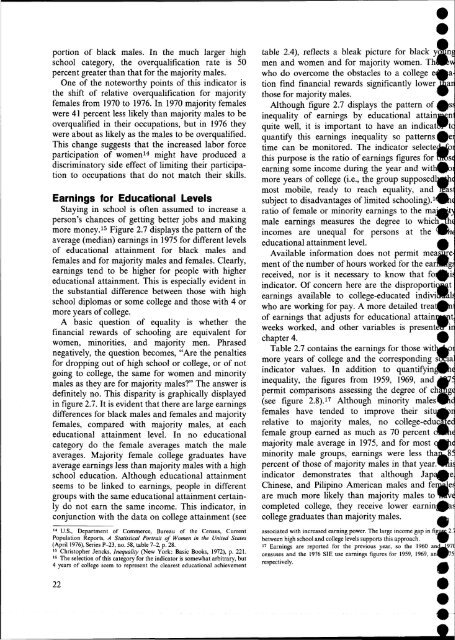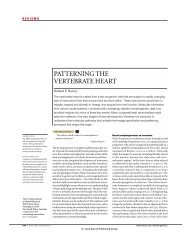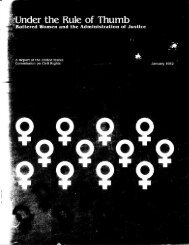Social Indicators of Equality for Minorities and Women - University of ...
Social Indicators of Equality for Minorities and Women - University of ...
Social Indicators of Equality for Minorities and Women - University of ...
- No tags were found...
You also want an ePaper? Increase the reach of your titles
YUMPU automatically turns print PDFs into web optimized ePapers that Google loves.
portion <strong>of</strong> black males. In the much larger highschool category, the overqualification rate is 50percent greater than that <strong>for</strong> the majority males.One <strong>of</strong> the noteworthy points <strong>of</strong> this indicator isthe shift <strong>of</strong> relative overqualification <strong>for</strong> majorityfemales from 1970 to 1976. In 1970 majority femaleswere 41 percent less likely than majority males to beoverqualified in their occupations, but in 1976 theywere about as likely as the males to be overqualified.This change suggests that the increased labor <strong>for</strong>ceparticipation <strong>of</strong> women 14 might have produced adiscriminatory side effect <strong>of</strong> limiting their participationto occupations that do not match their skills.Earnings <strong>for</strong> Educational LevelsStaying in school is <strong>of</strong>ten assumed to increase aperson's chances <strong>of</strong> getting better jobs <strong>and</strong> makingmore money. 15 Figure 2.7 displays the pattern <strong>of</strong> theaverage (median) earnings in 1975 <strong>for</strong> different levels<strong>of</strong> educational attainment <strong>for</strong> black males <strong>and</strong>females <strong>and</strong> <strong>for</strong> majority males <strong>and</strong> females. Clearly,earnings tend to be higher <strong>for</strong> people with highereducational attainment. This is especially evident inthe substantial difference between those with highschool diplomas or some college <strong>and</strong> those with 4 ormore years <strong>of</strong> college.A basic question <strong>of</strong> equality is whether thefinancial rewards <strong>of</strong> schooling are equivalent <strong>for</strong>women, minorities, <strong>and</strong> majority men. Phrasednegatively, the question becomes, "Are the penalties<strong>for</strong> dropping out <strong>of</strong> high school or college, or <strong>of</strong> notgoing to college, the same <strong>for</strong> women <strong>and</strong> minoritymales as they are <strong>for</strong> majority males?" The answer isdefinitely no. This disparity is graphically displayedin figure 2.7. It is evident that there are large earningsdifferences <strong>for</strong> black males <strong>and</strong> females <strong>and</strong> majorityfemales, compared with majority males, at eacheducational attainment level. In no educationalcategory do the female averages match the maleaverages. Majority female college graduates haveaverage earnings less than majority males with a highschool education. Although educational attainmentseems to be linked to earnings, people in differentgroups with the same educational attainment certainlydo not earn the same income. This indicator, inconjunction with the data on college attainment (see14 U.S., Department <strong>of</strong> Commerce, Bureau <strong>of</strong> the Census, CurrentPopulation Reports, A Statistical Portrait <strong>of</strong> <strong>Women</strong> in the United States(April 1976), Series P-23, no. 58, table 7-2, p. 28.15 Christopher Jencks, Inequality (New York: Basic Books, 1972), p. 221.16 The selection <strong>of</strong> this category <strong>for</strong> the indicator is somewhat arbitrary, but4 years <strong>of</strong> college seem to represent the clearest educational achievementtable 2.4), reflects a bleak picture <strong>for</strong> black ycmen <strong>and</strong> women <strong>and</strong> <strong>for</strong> majority women. Thfwho do overcome the obstacles to a collegetion find financial rewards significantly lower {those <strong>for</strong> majority males.Although figure 2.7 displays the pattern <strong>of</strong> (inequality <strong>of</strong> earnings by educational attain]quite well, it is important to have an indicatequantify this earnings inequality so patterns (time can be monitored. The indicator selecteethis purpose is the ratio <strong>of</strong> earnings figures <strong>for</strong>earning some income during the year <strong>and</strong> withmore years <strong>of</strong> college (i.e., the group supposed!most mobile, ready to reach equality, <strong>and</strong>subject to disadvantages <strong>of</strong> limited schooling). 1

















